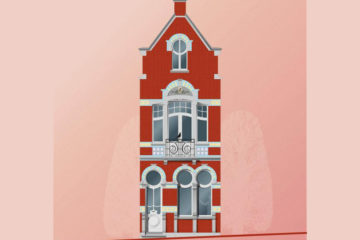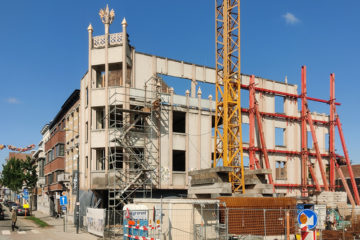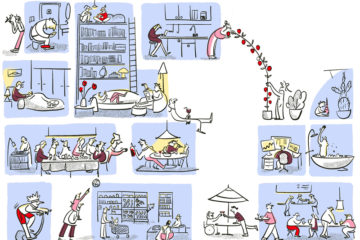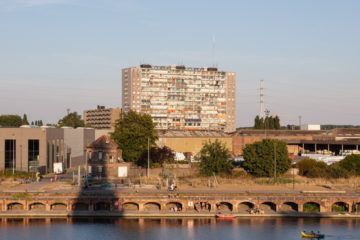In april 2015 komt Emilio Tuñón naar België op uitnodiging van de Universiteit Hasselt. Dat gebeurt in het kader van de Francqui Leerstoel die de Faculteit Architectuur en Kunst uitreikt aan Tuñón. Op 22 april geeft hij een lezing in C-mine, zodat ook het publiek buiten de universiteit kennis kan maken met zijn werk.
De Spaanse architect Emilio Tuñón maakte naam met enkele grote culturele projecten. Op zijn palmares staan prestigieuze en bekroonde musea, in belangrijke historische settings. Daarbij valt telkens op hoe zorgzaam Tuñón omgaat met de bestaande omgeving en de stedelijke waarden.
In 1992 richtte hij samen met Luis Mansilla het bureau Mansilla + Tuñón Architects op in Madrid. Hun projecten wonnen prijzen in Europa, Noord-Amerika en Azië. Zo mochten ze de Mies van der Rohe Award 2007 in ontvangst nemen voor het Museum van de Hedendaagse Kunst in León. Na het overlijden van Mansilla in 2012 gaat Tuñón verder onder de naam Emilio Tuñón Architects.
Tuñón is professor aan de universiteit van Madrid. Ook andere universiteiten – Princeton, Harvard, Lausanne, … – verwelkomen hem graag als gastprofessor.
Architecture of the memory
Tuñón laat zich inspireren door een essay van Emilio Lledó, The framework of beauty and the desert of architecture, uit 1984. In deze filosofie heeft architectuur een dubbele inbedding: het heeft zowel een plaats in de natuur als in de cultuur.
De mens wordt geconfronteerd met het lot dat de natuur hem oplegt en probeert daar impact op uit te oefenen. Hij beeldt zichzelf in dat hij de natuur kan beïnvloeden en vindt zo ‘vrijheid’ uit. De mens worstelt om zijn plaats te vinden bij de opbouw van de andere wereld: de cultuur, een tweede – zuiver menselijke – natuur. Cultuur begint waar natuur eindigt.
Emilio Tuñón verenigt in zijn werk een verwondering voor wat gegeven is – de natuur, de stedelijke context, … – en een verwondering voor wat de mens kan maken. Spanningen tussen natuur en cultuur zijn prominent aanwezig, zowel in de vorm en de materialiteit van het project als in de relaties met de omgeving.
Praktisch
Lezing Emilio Tuñón in het Engels
Woensdag 22 april 2015, 20u15
C-mine cultuurcentrum Genk, grote zaal
Inkom: 8 euro of 3,5 euro voor studenten
Reservatie via c-minebezoekersonthaal@genk.be
——
English version
In April, architect Emilio Tuñón is coming to Belgium at the invitation of Hasselt University in the context of the Francqui Chair. With this lecture series, Architectuurwijzer is also giving the public outside the university the opportunity to become acquainted with his work.
Spanish architect Emilio Tuñón made his name with major cultural projects. Amongst his credits are prestigious and award-winning museums, in important historical settings. When considering these projects, one is constantly struck by the care with which Tuñón integrates the existing environment and urban values.
In 1992, together with Luis Mansilla, he founded the firm Mansilla + Tuñón Architects in Madrid. Their projects won awards in Europe, North America and Asia. They received the Mies van der Rohe Award 2007 for the Museum of Contemporary Art in León. After the death of Mansilla in 2012, Tuñón carried on under the name Emilio Tuñón Architects.
Tuñón is a professor at the University of Madrid. In addition, other universities such as Princeton, Harvard and Lausanne have been pleased to welcome him as a guest professor.
Architecture of the Memory
Tuñón draws inspiration from a 1984 essay by Emilio Lledó, The Framework of Beauty and the Desert of Architecture. Architecture is doubly embedded in this philosophy: it has a place both in nature and in culture.
Humans are confronted by the fate that nature imposes on them and attempt to make an impact on it. They imagine that they can influence nature and in so doing discover ‘freedom’. Humans struggle to find their place in the building of the other world: culture, a second nature, one that is purely human. Culture begins where nature ends.
In his work, Emilio Tuñón combines wonder at what is given – nature, the urban context – and wonder at what humans can create. Tensions between nature and culture are front and centre, in the form and the material of the project, as well as in the relationships with the environment.
How to Attend
Wednesday, 22 April 2015, 8:15 PM
C-mine cultuurcentrum Genk, large hall
Admission: 8 euros and 3,5 euros for students
Reservations via c-minebezoekersonthaal@genk.be




